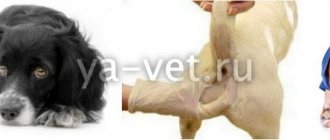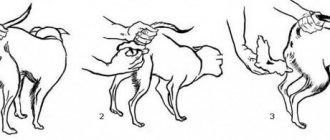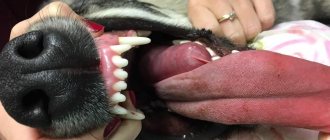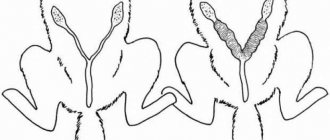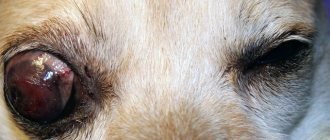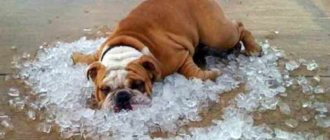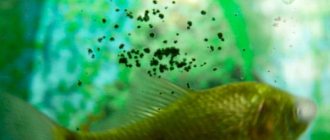What are paraanal glands?
Paraanal glands are special sacs located symmetrically on the sides of the rectum in the area of its transition to the anus. They are responsible for the production of a special secretion with a pungent odor, with the help of which:
- animals mark territory or attract the opposite sex;
- a kind of lubrication occurs to facilitate the process of defecation.
The causes of blockage of the paraanal glands can be:
- irregular or infrequent walks, which requires holding bowel movements;
- sedentary lifestyle;
- unbalanced diet (including feeding bones or excess protein in the diet);
- the presence of certain parasites in the body;
- frequent stool disorders;
- anal trauma;
- hereditary factors.
Location
The mysterious organ is hidden right behind the anus - not far from its transition to the rectum. It consists of two symmetrical “bags” filled with odorous secretion. Due to their location, these seals cannot be seen, but can be felt.
Operation
The secretion secreted by the paraanal glands in dogs has an individual smell. It is this that animals “read” when getting to know each other, when they sniff the back of the body of a new acquaintance.
In the absence of pathologies, the secretion produced periodically comes out. This occurs when defecation, leaving territorial marks or strong emotional arousal.
When natural outflow is disrupted, fluid accumulates inside. Blockage of the excretory ducts is accompanied by inflammation of the organ. This can lead to a number of complications, including tissue rupture. To save the animal, cleansing is done manually.
What is the danger of blocked anal glands in a dog?
- Inflammation
This problem arises as a result of prolonged accumulation of secretion in the paraanal glands, due to which this content simply begins the process of rotting.
Inflammation manifests itself in the form of redness, rash, and other irritation around the anus. Also, the dog feels discomfort and behaves restlessly.
When inflammation occurs, the animal will feel pain.
If inflammation of the paraanal glands occurs in dogs, self-cleaning at home is PROHIBITED.
- Abscess
In this case, the anal sac becomes overfilled with secretion and bursts.
An abscess is a serious consequence, the symptoms of which are fever, lethargy, apathy, as well as inflammation around the anus, an unpleasant odor and flow from the anus.
In this case, treatment must begin immediately, since the abscess can be fatal.
- Saculetomy
Saculetomy or removal of the paraanal glands is a forced procedure that is prescribed in case of regular blockage.
The operation is not complicated and the body’s recovery process occurs quite quickly, as a result of which the animal will feel good and comfortable, and the owner will not need to worry about the condition of his pet.
The health of the dog is the responsibility of the owner, therefore, it is the person who must help his pet in case of illness.
Blocked anal glands in dogs are not a common problem, but they do occur, and any dog owner should be aware of the symptoms and treatment options.
At-risk groups
Despite the fact that inflammation of the paraanal glands can occur in any dog, there are still categories of animals in which this phenomenon occurs more often. This primarily applies to representatives of small breeds, such as pugs, Shih Tzus, Pekingese, dachshunds, and Spitz. To avoid problems, you need to carefully monitor your pet’s diet, avoiding excessive weight gain, and ensure regular long walks.
Paraanal glands in dogs: symptoms of inflammation
Cleaning a dog's teeth with ultrasound without anesthesia
The symptoms of the inflammatory process in the anal glands largely depend on the stage of the disease. Inflammation is characterized by a number of main and indirect symptoms.
The main symptoms include:
- at the first stage of the inflammatory process, debilitating itching appears, which forces the pet to scratch the anus area. At the same time, the amount of secreted secretion is significantly reduced, and its color becomes dull white;
- at the second stage, the amount of secretion becomes critically small, its consistency becomes thick. Thinning of the coat is observed. A rash in the form of small pustules is observed on the inside of the thighs. The dog experiences pain in the hind limbs;
- signs of the third stage of inflammation - the secretory fluid becomes creamy and changes color to brown. The itching intensifies, and the dog may occasionally experience convulsions and tremors in the hind limbs;
- The fourth stage of the disease is characterized by darkening of the secretion to a brown or dark gray color, paralysis of the hind limbs.
Indirect symptoms include:
- changes in the pet’s habits, including the appearance of unmotivated aggression. The dog gets nervous, especially when the owner touches the tail;
- complete lack of appetite in the dog. In addition, the dog is constantly in a depressed mood;
- the dog experiences painful sensations that are localized in the area of the tail base, anus and testicles;
- The dog experiences a significant deterioration in the quality of its coat and skin. Hyperkeratosis appears - flaky skin seals, and pigmentation also increases;
- erythema, erosion, fistulas may indicate that the inflammatory process is becoming chronic;
- hyperthermia and fever in a dog can be observed in the acute phase of inflammation;
- The dog experiences swelling and redness in the anus.
There are direct and indirect symptoms of inflammation of the paraanal glands
Note! The owner is quite capable of providing his pet with timely assistance by cleaning the anal glands on his own. However, you need to be aware that non-professional intervention at home is permissible only at the initial stage of the inflammatory process.
Possible causes of inflammation
For pets, the exocrine function has long ceased to be necessary. They do not fight for the female and rarely mark territory. The once important organ gradually becomes rudimentary and is less and less cleansed naturally.
Other causes of inflammation of the paraanal glands in dogs include:
- low activity and excess weight, which impair intestinal motility;
- frequent digestive problems including diarrhea and constipation;
- weak immunity;
- improper feeding of bones, excess protein, insufficient or excessive amount of fiber in the diet;
- frequent mating and pregnancy;
- infection with bacteria, viruses or helminths;
- anal area injuries;
- infrequent walks, forcing you to restrain the urge to defecate;
- neglect of hygiene;
- congenital disorders in the development and position of the organ.
Establishing the cause of inflammation is an important part of further therapy. Eliminating it increases the chances of preventing relapses.
Associated symptoms
How can you tell from the symptoms that your dog needs treatment? Inflammation of the paraanal glands, like any other disease, occurs in several stages. At first, the inflammatory process may not produce any symptoms. As the secretion accumulates in the “bags,” the dog begins to experience a slight itch and tries to lick more often under the tail, from where the liquid with the smell flows.
At the second stage, the secretion secreted in small quantities has a thick, viscous consistency. The discomfort intensifies; you may notice that the gland is inflamed and swollen. Hair begins to fall out in the problem area, and small ulcers appear around the dog's anus.
The third stage is characterized by a meager amount of secretion. Consistency – creamy, dark in color. The dog experiences pain, constantly licks the area of redness, becomes nervous, and may show aggression towards the owner. Inflamed areas are noticeable on the butt. Indirect signs: partial or complete loss of appetite, increased body temperature, lethargy and apathy.
At the fourth stage, the discharge acquires the consistency of clay. The color of the secretion is dark brown, almost black. There is an abundance of mucus. Partial or complete paralysis of the lower extremities occurs. The itching intensifies, a swelling appears in the form of a lump - an abscess. Whenever you touch the site of inflammation, the animal experiences severe pain.
Abscess symptoms
The external manifestations of the pathology are specific, and it is often easy to make a differential diagnosis with other diseases.
Main symptoms include:
- Redness, local increase in temperature. The affected areas of the skin are hot to the touch, with pronounced hyperemia due to an active inflammatory process.
- Swelling. A characteristic symptom of an abscess. Develops due to the accumulation of pus in a confined space. The lump, inconspicuous at first, swells within a few days and begins to fluctuate. 3-4 days after the enlargement, spontaneous rupture is possible with pus coming out.
- Pain. The dog becomes restless and tries not to disturb the affected area. When you touch the abscess, jerking and whining are possible.
- Hair loss. Due to tissue breakdown, hair falls out at the site of the abscess and around it.
- With an extensive process, depression occurs and the overall body temperature rises.
The deep form can only be diagnosed using additional tools. Externally, one can suspect the presence of an inflammatory process by the animal’s restlessness and pain in a certain place.
Stages of development of the inflammatory process
Acute inflammation of the paraanal glands is an extremely rare occurrence. Most often, the disease develops gradually. This is why the owner often misses the onset of the disease. It is customary to distinguish the following stages of development of the pathological process:
- violation of the outflow of secretions from the paraanal glands;
- accumulation of too much secretion in the bags;
- gradual thickening of the contents of the glands;
- the onset of the inflammatory process, accompanied by pain and discomfort;
- infection by pathogenic microbes in the anal area;
- intensification of the inflammatory process and, as a result, the appearance of purulent discharge from the dog’s anus;
- abscess and formation of fistula tracts.
How to determine the need for cleaning?
If the secretion accumulates for a long time, the dog develops unpleasant sensations in the corresponding place, and it tries to get rid of the contents of the bags on its own. In such situations, the animal may:
- ride on your butt on the floor (especially on fleecy surfaces) to squeeze out the contents of the bags and get rid of discomfort;
- lick and chew the area under the tail (even to the point of gnawing out fur)
- suddenly jump up and twist towards the tail in search of non-existent fleas.
Blockage of the paraanal glands should be distinguished from the presence of worms, perineal hernia, or manifestations of allergies.
An unpleasant odor may also appear from the anus, which was not previously observed.
If your pet exhibits the symptoms listed above, it may need to have its anal glands cleaned. If there is no inflammation in the anus area and the dog does not experience pain when pressed, the procedure can be carried out independently. This procedure does not require special skills, but is not one of the most pleasant, so squeamish people are better off seeking help from a veterinarian.
Need for removal
Some animals have regular blockages, and even regular cleanings do not allow the secretions to come out. If this has to be done quite often (almost every week), then the veterinarian may recommend surgery to remove the anal glands as the only possible option to avoid relapses. Since this is not a vital organ, surgery will be a more humane option compared to the stress that the animal experiences during cleaning.
The removal operation is called sakulectomy and is classified as not complicated. The veterinarian makes shallow cuts in the skin in the area of the glands, then takes them out and cuts them off, suturing the wounds. During the operation, the rectum or anus is not affected, so the very next day the dog can defecate on its own and feels as usual. To avoid sutures coming apart and stretching, veterinarians recommend a light diet and frequent walks. Until the wounds are completely healed, the pet should not tolerate urges.
How to clean your dog's anal glands yourself
Before you begin the cleaning procedure, you must make sure that your dog has a problem with the anal glands.
To do this, you need to palpate the anus from the inside. It is best to carry out this procedure with gloves. Insert your index finger shallowly into the hole (almost at the very exit) and gently begin probing. If there are no seals, the bags are soft and practically cannot be felt, then you can be sure that everything is in order. If the dog’s paraanal glands are clogged, then even with light pressure you will immediately feel a compaction.
If you find seals, then you can safely begin the cleaning procedure.
What you will need
Prepare:
- Gloves.
- Paper napkin or clean rag.
- Basin.
- Petrolatum.
Method one
Do the following:
- Place your pet in the bathtub. If the dog is small, then you can use a simple basin.
- Ask someone from your household to hold the four-legged animal by the muzzle and body so that it does not spin or struggle.
- Put on gloves and feel the glands from the outside.
- Next, take the dog by the base of the tail and lift the tail up as far as possible, but so as not to cause pain to the animal.
- With another gloved hand or just using a napkin, use your thumb and forefinger to apply pressure to the area on the sides of the anus. If you did everything correctly, a viscous, unpleasant-smelling beige liquid should come out of the bags.
- After this, rinse everything thoroughly with water.
If after this procedure there is no result, and the paraanal glands are not freed from secretion, then under no circumstances press with double force. In this case, it is better to contact a veterinary clinic. It is possible that the glands are so clogged that home cleaning will not help and surgery will be required to remove the sacs.
Method two
Try this:
- Place your pet in the tub or basin and have someone help hold the animal.
- Wear gloves.
- Lubricate the index finger of your right hand (on top of your gloves) with Vaseline.
- With your left hand, in the same way as I described in the first method, lift the dog’s tail as much as possible.
- Carefully insert your index finger, lubricated with Vaseline, into the animal's anus. The palm should be in a position perpendicular to the floor.
- Using the index finger of your right hand, gently feel the gland.
- Next, use the index finger of your right hand (inside the anus) and the thumb of the same hand (outside the anus) to press the pouch, squeezing the secretion out.
- Rinse everything off with water.
It goes without saying that this procedure will not give your pet any pleasure. Therefore, together with your assistant, act harmoniously. The assistant must hold the four-legged firmly (but not painfully) so that he does not escape. Talk to the animal, calm it down, praise it.
As a rule, such cleaning lasts for a maximum of six months. But if you regularly carry out preventive measures, then it is quite possible that in the future you will not need to do such a procedure at all.
Frequency
On average, it is enough to clean the ducts every six months. Depending on the individual characteristics of the animal, the interval can be increased or decreased. If blockage occurs monthly or even more often, then the problem is eliminated surgically.
How to clean?
Below are two methods that allow you to clean bags of accumulated secretions at home.
First way.
- Place the animal in a bath or basin.
- Ask an assistant to hold the pet's body and muzzle so that it does not struggle or squirm.
- Put on gloves and feel the seals from the outside.
- Raise the base of the tail as high as possible to relax the sphincter without causing pain to the animal.
- With your free gloved hand or using a napkin, use your thumb and forefinger to squeeze the sides of the anus.
- If everything is done correctly, a viscous beige liquid with an unpleasant odor will be released from the bags.
If after all the actions it was not possible to free the anal sacs, then you should not increase the pressure on them. It is possible that they are so clogged that it is impossible to clean them at home, and you should contact your veterinarian.
Second way.
This method is only suitable for large breeds.
- Place the animal in a basin or bathtub and ask another person to hold it.
- Put on gloves and lubricate the index finger of your right hand with Vaseline.
- With your left hand, by analogy with the first method, raise the base of the tail to the top.
- Slowly insert your index finger lubricated with Vaseline into the anus. In this case, the palm should be perpendicular to the floor.
- Feel the gland inside the anus with your index finger.
- Squeeze out the secretion by pressing simultaneously with your index finger from the inside and your thumb from the outside of the anus.
After completing all the manipulations, you need to wash your pet to get rid of the pungent odor of the secretion. On average, cleaning lasts for six months maximum, but the frequency of cleaning is selected for a specific animal depending on the speed of clogging. But if you pay enough attention to preventive measures, then there is a chance that such actions will not be needed in the future.
Even if you managed to clean it yourself, it is advisable to seek examination and advice from a veterinarian in order to identify and eliminate the causes of this phenomenon.
Diagnostic methods
When the first alarming signs appear, such as changes in behavior, nervousness, lethargy, apathy of the dog, frequent licking under the tail, you should immediately show your pet to a veterinarian. You can diagnose inflammation yourself. In later stages, the tumor site can be seen with the naked eye. If the inflammation is minor, you can make sure that the mucous membrane in the anal area is swollen using a rectal examination. To do this, wear sterile gloves and carefully insert your finger into the anus. If the “bags” are inflamed, they increase in size.
After an examination at the veterinary clinic, if pathology is present, the doctor will immediately prescribe the necessary procedures to alleviate the dog’s condition. In the initial stages of inflammation, additional laboratory tests of blood and urine may be required.
In the presence of purulent discharge and an abscess with impurities of blood and a foul odor, we can talk about the addition of a bacterial infection.
Treatment methods
In most cases, treatment is limited to mechanical methods. Only in the most advanced cases surgical intervention is required. In general, the treatment looks like this:
- drug therapy. First of all, these are rectal anti-inflammatory suppositories, which, in addition to their antibacterial effect, have powerful regenerating properties. To reduce pain, painkillers are prescribed;
- washing. For those pets diagnosed with stage 3 or 4 of inflammation, the glands are washed to remove accumulated purulent exudate. In this case, local anesthesia is used. If an abscess is detected, the specialist will open it, remove the contents, and wash the ducts with an antiseptic. As a rule, the wound quickly regenerates if the dog is not allowed to lick the affected area. For this purpose, a special cone is prescribed, which is put on the pet’s neck;
- mechanical cleaning. This method is used when the inflammatory process is at stages 1-2. Usually there are two ways to clean the glands - external and internal. The first method involves grasping the glands from the outside and gently pressing them towards each other. The second method involves inserting a finger into the dog’s anus, with which the gland is felt. With the help of gentle massage manipulations, the contents of the organ are squeezed out. This method is usually used either by a doctor in a clinic or under the supervision of a specialist;
- surgical intervention. An operation to remove the paraanal glands—sacculectomy—is indicated in cases of frequent relapses, chronic inflammatory process, and congenital pathology. The operation is not considered complicated, since it does not affect other organs of the pet. Within a day, the dog returns to his normal lifestyle.
Complications
If you do not clean the anal glands in time, there is a risk of developing complications that require longer and more complex treatment. These include inflammatory processes that are caused by rotting of secretions accumulated in the anal sacs under the influence of bacteria. In this case, the following are added to the characteristics listed above:
- swelling and redness of the anus;
- rash and irritation near the anus;
- getting wet and losing hair around the base of the tail;
- obvious pain during bowel movements in a sitting position
Inflammation is more common in young animals, but there are no patterns associated with breed characteristics.
In case of inflammation, it is not recommended to resort to self-cleaning. You should contact a veterinarian who will provide the correct treatment.
The treatment process includes:
- mechanical cleaning of inflamed sacs;
- sinus lavage;
- treating the skin with an antiseptic;
- administration of antibiotics;
- further observation and preventive measures.
In what cases does a pet need cleaning of the paraanal glands?
The owner should take care to clarify the diagnosis immediately when the first signs of incipient inflammation appear. You should not put off visiting the veterinarian. It is especially important to seek advice from the clinic for those owners who are encountering this phenomenon for the first time and do not have the skills to independently clean this important canine organ.
Veterinarian during consultation:
- will explain how to properly monitor your pet’s anal glands;
- will show how to remove stagnant secretions;
- will make the necessary appointments to avoid complications or relapse of the inflammatory process;
- will talk about preventive measures.
The main thing is to contact a specialist in time
Prevention of blockage of the paraanal glands
To avoid problems and prevent the negative consequences of inflammatory processes, it is worth providing your pet with high-quality prevention. To do this, you need to follow these recommendations:
- Walk your pet often. The less often the dog empties its intestines, the worse the secretion is removed from the glands.
- Walking is quite active. An insufficiently active lifestyle causes constipation in your pet and provokes inflammatory damage to the glands.
- Monitor your dog's diet. It is important to ensure that the stool is properly formed. This will help avoid the development of constipation and diarrhea. Abnormal bowel movements increase the likelihood of blockage and inflammatory damage to the paraanal glands. Excessive amounts of protein and carbohydrates in the diet often cause constipation. A dog's diet must contain a sufficient amount of fiber. It helps normalize digestive functions.
- Carry out hygienic procedures systematically. In this case, it is worth assessing the condition of the glands. Young animals are recommended to perform a similar check annually. For older pets this is done more often - every 6 months.
Diet
A balanced diet is a key factor in preventing inflammation of the paraanal glands. If your pet has a tendency to blockage of the anal glands, then it is important to ensure the normal functioning of the digestive system.
Important! Good peristalsis is ensured by the inclusion of a sufficient amount of fiber and dietary fiber in the diet.
If your dog eats exclusively industrial food, then you should choose from those types that are recommended for dogs with digestive problems. The serving size and number of doses are calculated by the veterinarian, taking into account the individual characteristics of the pet.
Often, the veterinarian prescribes a vitamin and mineral complex to strengthen the pet’s immunity.
Diet and an active lifestyle are the best prevention of blockage of the paraanal glands
Sonation of the paraanal glands
Pet hygiene is the responsibility of the owners. Cleaning your teeth and ears should not be difficult after some preliminary training and practice. But the issue of hygiene of the paraanal glands becomes a difficult task for some owners, and absolutely impossible for those who are particularly squeamish. If you wish, the veterinarians of the Veterinary House clinic will explain to you how to properly clean the glands in dogs , and if you do not want to perform the manipulation yourself, they will determine the interval for filling the bags and draw up the best schedule for visits to the clinic.
The anal sacs (glands) are located on the sides and slightly below the anus. These bags are gradually filled with a special secretion, with the help of which the animal marks its territory. It has an individual unpleasant odor and is a kind of personal marker of a particular individual. During each bowel movement, fecal pressure is exerted on the glands, causing fluid to be removed from the body. In other words, cleaning the glands in cats and dogs is often done independently; owners may not even know about the existence of such a problem.
When secretions accumulate inside the glands for a long time, pets begin to experience discomfort near the anus area. Following their instincts and trying to get rid of unpleasant sensations and squeeze out the liquid, dogs begin to crawl on the floor, rub against carpets or other surfaces with pile. If relief does not come, the animal begins to gnaw the area at the base of the tail, shows more and more anxiety, sometimes suddenly jumps up and tries to wriggle towards its croup, as if catching someone invisible. Feel the area under the tail using gloves for hygiene purposes. When you feel tight areas with gentle pressure, this means that the sacs are definitely full and cleaning of the anal glands in dogs should be done soon.
How to avoid blocked anal glands in a dog?
There is a list of recommendations that if you follow, you will never know that dogs are suffering from a similar illness.
- Try to arrange walks for the animal as often as possible, as this will avoid the dog having to endure waiting for the opportunity to relieve itself.
- give the animal the necessary physical activity, since a sedentary lifestyle can cause malfunctions in the dog’s body;
- pay close attention to your diet. The dog should eat a balanced and regular diet;
- During a routine veterinary examination, ask your doctor to examine your dog's anal glands, especially if you have observed any of the above symptoms.
How inflammation of the paraanal glands is treated in the clinic
Failure to clean the dog's paraanal glands in a timely manner leads to inflammation. The dog's owner rarely examines the area of the anus, hoping that the dog itself will lick and sterilize with saliva any emerging foci of the disease.
However, this is not always correct. If the owner missed the onset of the disease, and it proceeds latently (hidden), then soon something like an abscess will form, and then a fistula.
This is a very unpleasant situation, since these areas of the dog are very sensitive, and he experiences unbearable pain. The worst thing is if fungal pathogens are involved in the infection. They are difficult to identify and more difficult to treat.
It is inflammation of fungal etiology that most often leads to the formation of a fistula. The pus coming out of the canal has a thick, grainy consistency. The grains are mycelium.
Fistulas are similar to abscesses, but their treatment approach is completely different. Diseases must be distinguished from each other. This can be done by palpating the area around the inflammation.
With an abscess, you can easily detect a cavity shallow under the skin. In the first stages of an abscess, the skin in this area will be tense and the temperature will be elevated. With a fistula, after opening the abscess, the temperature will not rise.
You can also see uneven, “shaggy” edges of the wound when an abscess has opened. The fistula's outlet looks like a volcano with walls made of hardened, healed tissue. Traces of healing are visible along the edges of the abscess, which is never observed with fistulas.
For closed abscesses, the doctor prescribes hot compresses, which are applied until the abscess is completely ripe. After this, the veterinarian will open the lesion, wash it with saline solution and antiseptics.
It is impossible to treat such a complication at home. The veterinarian will excise the affected tissue, suture the wound canal, and eliminate the cause of the formation of the fistula.
The patient will be prescribed a course of strong antibiotics and all the necessary tests will be done, if necessary.
The doctor performs the following procedures:
- Shaves the area around the inflammation.
- Cleans bags mechanically.
- Flushes the sinuses.
- Treats everything that is needed with antiseptics.
- Performs an anesthetic blockade.
- Gives an antibiotic injection.
- Prescribes outpatient treatment.
- Provides follow-up and preventive measures.
It takes a long time to treat inflammation. Therapy will include pain blockades, a course of broad-spectrum antibiotics, and the injection of Levomekol or Cephalexin ointment into the opening of the fistula. And perhaps wearing a special cap so that the dog cannot lick the sore spot.
If the pet licks the fistula, the infection will be locked inside the body and, without finding a way out, blood poisoning may develop.
Clinics of two capitals
